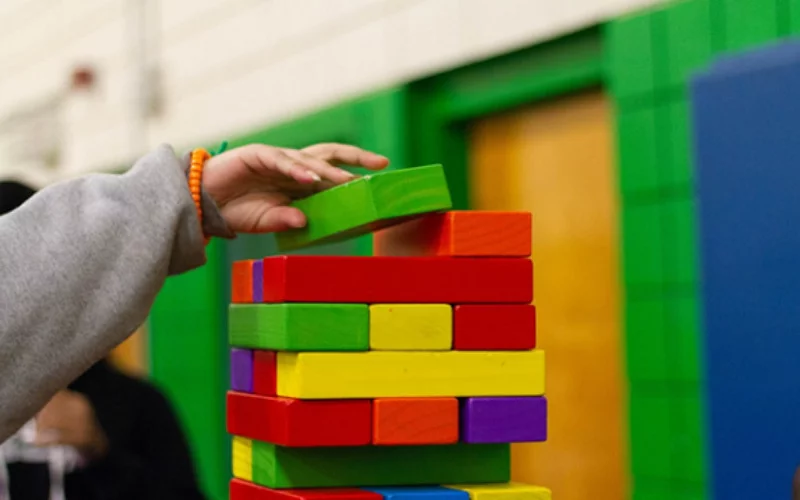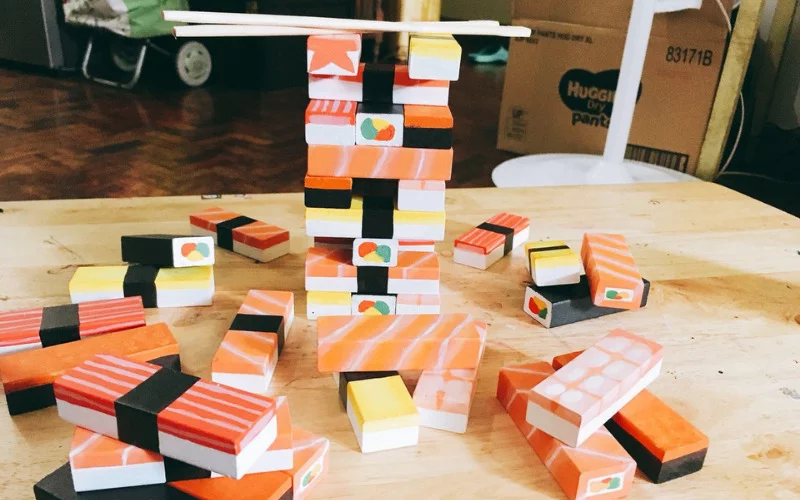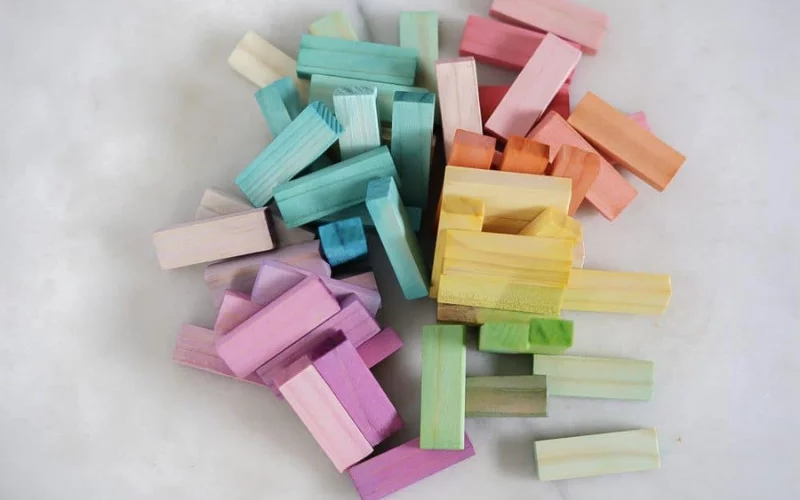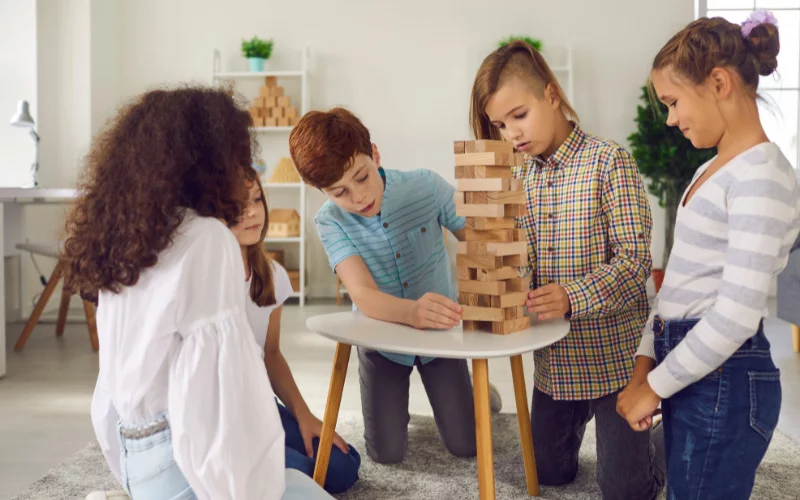The game of Jenga is a fun family game played by both the young and old from ages 6 through 60 and beyond. This classic ‘block-stacking and block-crashing’ game requires both physical and mental skills to play and win.
This game, now a household name, is interesting, captivating, and stresses and helps people bond. However, you can make the game more fun and lively by painting the block with different colors or patterns.
So Yes, you can finish your Jenga by simply painting it, and today we will teach you the type of paint you should use to paint the game, the benefits of playing the game, and some tips on how to win the game Jenga.
How Do You Finish Jenga
There are many painting materials and steps that you could use to finish your Jenga. Here are different materials for finishing your Jenga game:
1. Using A Spray Paint

You can use spray paint to finish your Jenga, and you should use water-resistant and quick-drying spray paints. All you need do is to follow these simple steps:
1. The first thing you have to do is use fine-grain sandpaper to smoothen the blocks’ surface and get rid of any splinter on the blocks.
2. Then, use a soft cloth to remove any debris or residue left on the blocks.
3. Just spread cardboards or newspapers on a flat surface and then position the blocks according to the color you will spray on each set of blocks.
4. Spray the blocks as they are standing upright, and then let them dry, and you then spray the bottom part of the blocks that are not fully sprayed. Just let the blocks sit until it is fully dried.
5. Then apply Polyurethane to seal the blocks, and when the blocks are completely dried, they are good to go.
2. Use Acrylic Paint

This is another great option for finishing your Jenga blocks. Acrylic paints are inexpensive, readily available, and easy to work with.
You need water and a brush to paint your Jenga with acrylic paint. The artist’s grade acrylic paint is the best type of paint for your Jenga.
There are the steps to painting your Jenga with acrylic paint:
1. First and foremost, you have to use the first-grade sandpaper to say d the blocks
2. Use a soft cloth to wipe the block free from any dust and ensure no splinter in the block because splinters in Jenga blocks can inflict painful injuries on the people plating the game.
3. Stand the blocks on a newspaper or carton, and then you should paint each block with the colors of your choice using the paintbrush and water. Remember to flip the blocks to paint the bottom part.
4. Allow the paint to dry properly, and afterward, spray clear acrylic to seal the blocks.
The beautiful thing about painting your Jenga with acrylic paint is that you will need to apply only a coat or 2 of paint to get the job done, and your block will look good, and the gloss will last for a long time.
3. Using Water Colour

You can use watercolor to finish your Jenga blocks if you are looking for a lighter-looking block; the only problem is that you will have to give several coats of the watercolor for the paint to come out fine and for it to last too.
The great thing about painting with watercolor is that kids can join in the fun because even if they make a mess, the paint can easily be washed off their clothes and bodies. When painting with watercolor, only a small quantity of water is needed if you want the color pigment to come out well.
You could make painting your kid’s Jenga blocks one of the side entertainment for kids at a party, in which kids are allowed to paint a given number of blocks with a given color for fun, or you could even turn it into a competition to know who will be the first to finish painting a given number of blocks. They can do this with watercolor without fear of the color staying permanently on them or their clothes.
How To Make Your Colored Jenga Blocks Slide Better?
It is easier for you to enjoy playing Jenga if the blocks slider easily. You can achieve this by finishing your Jenga blocks already sprayed with paint with Polyurethane.
Simply spraying your Jenga blocks with acrylic will have the same effect. You can apply some coats of natural wax to make the blocks slide better, or you can resort to a special satin finish that is glossy that will make your Jenga blocks slide quite easily.
The Benefits Of Plating Jenga
The Benefits of playing Jenga is physical, psychological, and mental, and some of them include:
1. It helps to improve players’ motor skills, which is why it is a good game to introduce young kids to because it helps them develop the use of their small muscles.
2. It helps one develop manual dexterity, which is the ability to use the hand in performing complicated tasks skillfully and quickly while improving the player’s hand-eye coordination and problem-solving skills.
3. Jenga will help you become a strategic thinker since you learn to put a plan to achieve the desired outcome as you play the game while also helping your cognitive function, like helping you remember things.
4. You will develop patience as you play the game and improve your non-verbal reasoning ability.
5. This is a great game that serves as a stress therapy because it has been proven that Jenga helps lower blood pressure and reduce stress, especially with all the joy and laughter that comes with playing the game.
6. The game of Jenga is relaxing. It provides opportunities for family and friends to relax, communicate, and bond where memories that will last are created, which is better than communication via phone or text messages.
Tips On How To Win A Game Of Jenga
Like all games, a few tips will help you do great in the Jenga game. These tips are proven strategies and techniques that have been tested, and you can trust. These tips include:
1. Always push the blocks and not pull them, as pulling will disturb the tower’s balance.
2. You should start by removing the center block so that the tower will remain balanced by the side block.
3. If you have successfully removed the center blocks, then move the side blocks to the center by tapping them so that the structure will remain stable.
4. When a block is removed from the left, ensure that you place it on top of the tower to the right, and when you remove from the right side, then put it at the top left; this will ensure that the structure remains intact.
5. The thickest block should be removed last since they add stability to the structure.
6. You play Jenga with your non-dominant hand, which means you use your left hand if you are right-handed and vice versa.
7. Focus on just one move at a time.
8. Go slow, take your time and move wisely.
9. Before choosing a block to remove, test the tower by gently tapping the blocks with your finger to see which is loose and tight. Pick the loose blocks first.
10. Always take the blocks closer to the top; this ensures that the tower’s foundation remains intact.
11. If you have no option but to remove a block that is tight in the structure, then you should use the ‘door’ method in which you ‘swing’ the block open and then ‘close’ it again, this will loosen the block and move it closer to the edge, and this makes it a lot easier to be removed.
18. If you have used the ‘door’ method to loosen a tight block, remove the block by holding it with your ring finger and thumb while using your index finger and nail to support the block.
19. To win a game of Jenga involves a lot of practice which will involve several hours of playing the game and also taking mental and physical exercises that will keep fitting physically and mentally
Conclusion
Jenga is a great game that the whole family can play, and the potential with the blocks is endless. You can make your game more lively by adding g a coat or 2 of paints; these paints will also help your blocks slide better, making it easier for them to be removed.
The game has many physical and psychological benefits, and once you can adopt the right tips, you will be on your way to being a Jenga master.
Helpful Links:
- 4 Best Heavy Duty Ladder Ball Game
- How To Play and Win a Swingball Game
- How Do You Make a Wiffle Ball Strike Zone
- How To Hit A Ball In Croquet (See Rules Of Croquet)
- How To Install A Tetherball Pole In The Ground
We trust this article helped you learn how to finish Jenga. You may also want to check out How To Play and Win a Swingball Game.
Thanks for taking the time to read our article, and we hope you find it helpful. Would you mind leaving a comment below if you have any suggestions?
Kindly reach out to people by sharing this post on social media.
If you liked this article, then please follow us on Facebook, Instagram, and Pinterest.

